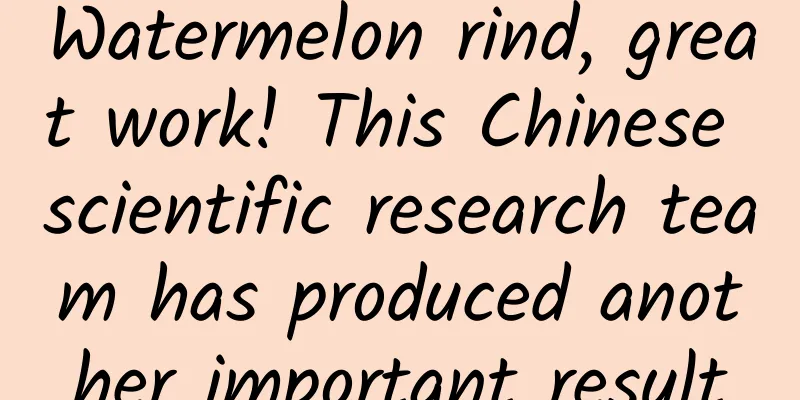Watermelon rind, great work! This Chinese scientific research team has produced another important result

|
Recently, Sun Licheng's team from the Future Industry Research Center and the School of Science at Westlake University published a breakthrough research result in Nature Communications. Inspired by watermelon peel membranes, they proposed a strategy to construct a new type of ion transport membrane (ITMs), which showed excellent performance in the electrochemical carbon dioxide reduction reaction (CO2RR). The watermelon rind membrane is the outermost green membrane of the watermelon rind. After being frozen and peeled off, it is only about 75 microns, about the diameter of a hair, but it shows a wonderful "design thinking". And this research started with that "iron fool". Sun Licheng's team is peeling off the thawed watermelon skin membrane During the Dragon Boat Festival in 2021, Liu Qinglu and Tang Tang worked overtime to do experiments. They bought watermelons from a vendor at the school gate, and put them in the quick-freeze layer so that they could cool faster. As a result, they were busy with the experiment and it was already a few days later when they remembered. Tang Tang chewed the ice slag while looking at the naturally peeled watermelon rind. Friends who often freeze fruits must know that the rind is easy to peel off after thawing. Tang Tang and Liu Qinglu discussed, isn't this watermelon rind a natural membrane? This is a design from nature , and it is also one of the research directions that Academician Sun Licheng's team is committed to - ion transport membrane . Ion transport membranes are key components of renewable energy conversion and storage systems such as electrochemical carbon dioxide reduction, water electrolysis and fuel cells . Their performance directly affects energy conversion efficiency and product collection costs . Currently, the widely used ion transport membranes are divided into four categories, but all of them have many limitations: The porous membrane has low energy efficiency and poor gas barrier properties; Proton exchange membranes rely on expensive platinum group electrocatalysts; The cost of collecting anion exchange membrane products is high; Ion-solvation membranes rely on a high concentration of potassium hydroxide electrolyte. The ion transport membrane in an ideal alkaline electrochemical carbon dioxide reduction reaction system should have selective permeability, like a "net" - allowing hydroxide ions (OH-) in the electrolyte to pass freely, but blocking the carbon dioxide liquid products in the cathode electrolyte - such as formate, acetate, ethanol, etc., thereby reducing the separation cost. This may seem a bit contradictory, but the watermelon rind that "passed the initial test" seems to have this magical ability. Schematic diagram of watermelon rind, which is mainly composed of three layers. Cuticle is the outermost stratum corneum, Epidermis is the epidermis, and Hypodermis is the subcutaneous tissue layer. Why does watermelon rind exhibit this ion selectivity? First of all, you need to have enough understanding of watermelon rind from a biological perspective. ****Through a variety of characterization techniques, the research team identified the main components of the cell wall, including cellulose, hemicellulose and pectin . Cellulose is regularly arranged to form a three-dimensional channel with a diameter of 2 to 5 nanometers, while pectin evenly fills this regularly arranged three-dimensional fibrous channel . Molecular dynamics simulation model of cellulose fiber bundles containing pectin At present, even the most advanced chip manufacturing technology can only produce logic circuits in a space below 5 nanometers. However, for watermelon rind, this is its "basic operation" and the "production drawings" are stored in DNA. The research team further subdivided the watermelon rind membrane and found that the subcutaneous layer performed best. How good is it? The conductivity of hydroxide ions in the subcutaneous membrane of watermelon rind after being soaked in 1 mol/L potassium hydroxide (KOH) at room temperature is better than the ion conductivity of 1 mol/L potassium hydroxide aqueous solution itself, that is, the watermelon rind membrane accelerates the transmission of hydroxide ions and allows the hydroxide ions to run faster. The next question is, how to learn and replicate the abilities of “model students”? It is obviously not enough to understand the subtle physical structure of the watermelon rind membrane, and we need to explore its deeper mechanism. Why does this intricate and fine channel only allow hydroxide ions to pass through, but exclude acid ions? Compared with discovering phenomena, exploring mechanisms is more difficult. Now, skipping the complicated and lengthy research process, let’s simply talk about the results. The research team discovered that in the transmission of hydroxide ions, the continuous hydrogen bond network formed by the microporous pectin filling the nanochannels in the cell walls of the watermelon rind through confinement played a key role, and the mechanism behind it has the magic of "walking through walls". The pectin in the cell wall can form bound water through the hydroxyl functional groups on its surface, thereby promoting the connection between water and forming a continuous hydrogen bond network in a confined space. Schematic diagram of hydrogen bond network chemistry. The process of hydroxide ion transfer is a bit like the "Newton's cradle" in physics. The research team further discovered through simulation calculations that the negatively charged carboxylate (-COO-) ions rich in pectin and the negatively charged formate ions "repel each other" and hinder the migration of formate ions, which was also confirmed by experimental results. The answer gradually emerged: on the one hand, the hydroxide ions were accelerated through the continuous hydrogen bond network and microporous channels, as if they were getting on a highway; on the other hand, the acid ions were repelled by the carboxylates in pectin and formed hydrogen bonds with the hydroxyl groups in pectin and cellulose, and they were dragged down. Dr. Tang Tang in the lab, now an associate researcher at Westlake University At this point, the mechanism of the "model student" watermelon peel membrane has finally been basically explored. The exquisite mechanism it demonstrates is guiding the laboratory to design a new ion transport membrane, and to prepare anion exchange membranes for water electrolysis and electrochemical carbon dioxide reduction reactions, which show ultra-high performance. These follow-up research and development are currently in the promotion stage. However, faced with the intricate nanoscale channels within the watermelon rind membrane and the complex structure and composition of the biomass in the cell wall, the research team, out of awe of nature, still dares not say that they have fully understood the mechanism of the watermelon rind membrane . |
<<: Are colored glasses poisonous? Come and see if your glass is poisonous
>>: Red alert! Typhoon Makar will land here, how should we respond?
Recommend
"People's hope" has not yet come true: Remdesivir still needs to be verified
The results of remdesivir in treating COVID-19 ar...
The 5 most worth-watching Spring Festival marketing cases in 2019!
Whenever the Spring Festival approaches, going ho...
Which one should I buy, quantum dot TV or OLED TV?
I want to buy a TV recently, but some people say t...
A brief talk about user operations, my AARRR model!
1. Start by reconstructing the AARRR model After ...
The boat is sailing in the sky
Six world records! Guizhou Hydropower Station &qu...
Advanced Douyin live broadcast room for food!
In just one month, the sales of a Douyin live bro...
Catch single atoms in a "trap" to measure the age of ice cores
The scientific expedition team drilled ice cores ...
Why do I spend money on information flow promotion but get no conversion?
" Why do you give me hope but let me down ?&...
A complete guide to taking screenshots of App Store apps!
This article is enough for setting screenshots for...
Shen Gong...Gong...What animals are the true forms of the leopard family?
With the popularity of "Nezha: The Devil Boy...
Can dogs not only follow human language commands, but also distinguish different human languages?
All things in the world have spirits, and life is...
Which copywriting do users like to read the most? Did you give the user anesthesia?
1. Which copywriting do users like to read the mo...
Teach you step by step the effective methods to improve your marketing and copywriting skills
As marketers , we generally have a good habit of ...
Tencent Cloud Server 11.11 Limited Time Flash Sale - 2 Cores 4G First Year 70 Yuan
Every year around Double 11, major cloud service ...
Not only can you delete your friends' voice messages in batches, but you can also pause WeChat and update many other functions.
Last Saturday morning, Shichao was sleeping sound...









